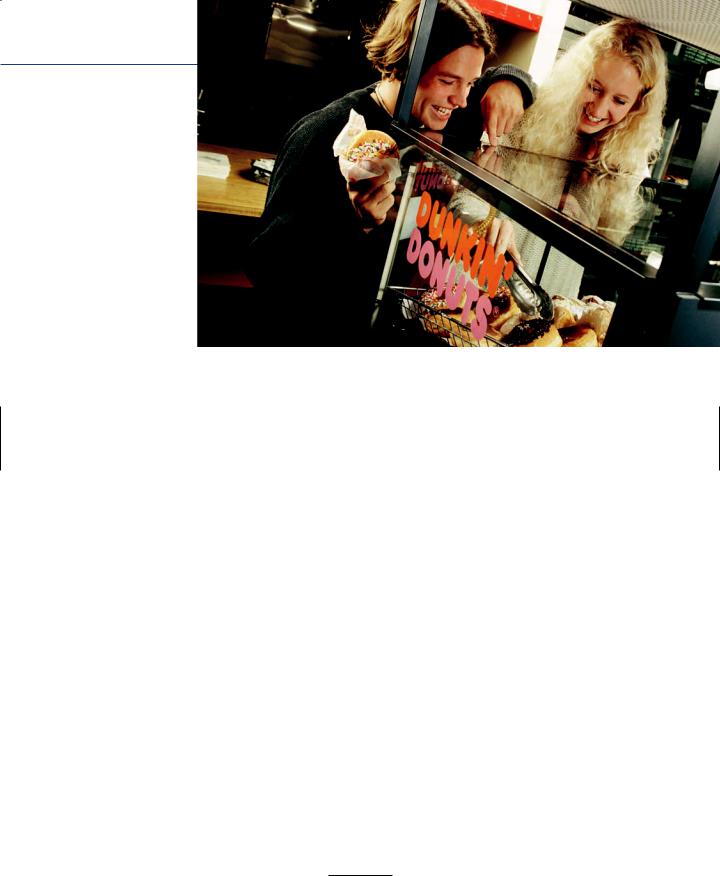
- •CONTENTS
- •PREFACE
- •Content—Benefits for Students
- •Content—Benefits for Instructors
- •Features of the Book for Students and Instructors
- •Supplementary Materials
- •Acknowledgments
- •What Is Hospitality Management?
- •The Manager’s Role in the Hospitality Industry
- •Why Study in a Hospitality Management Program?
- •Planning a Career
- •Employment as an Important Part of Your Education
- •Getting a Job
- •Employment at Graduation
- •The Outlook for Hospitality
- •Summary
- •Managing Change
- •Demand
- •Supply
- •Workforce Diversity
- •The Impact of Labor Scarcity
- •Summary
- •The Varied Field of Food Service
- •The Restaurant Business
- •The Dining Market and the Eating Market
- •Contemporary Popular-Priced Restaurants
- •Restaurants as Part of a Larger Business
- •Summary
- •Restaurant Operations
- •Making a Profit in Food Service Operations
- •Life in the Restaurant Business
- •Summary
- •Chain Restaurant Systems
- •Independent Restaurants
- •Franchised Restaurants
- •Summary
- •Competitive Conditions in Food Service
- •The Marketing Mix
- •Competition with Other Industries
- •Summary
- •Self-Operated Facilities
- •Managed-Services Companies
- •Business and Industry Food Service
- •College and University Food Service
- •Health Care Food Service
- •School and Community Food Service
- •Other Segments
- •Vending
- •Summary
- •Consumer Concerns
- •Food Service and the Environment
- •Technology
- •Summary
- •The Evolution of Lodging
- •Classifications of Hotel Properties
- •Types of Travelers
- •Anticipating Guest Needs in Providing Hospitality Service
- •Service, Service, Service
- •Summary
- •Major Functional Departments
- •The Rooms Side of the House
- •Hotel Food and Beverage Operations
- •Staff and Support Departments
- •Income and Expense Patterns and Control
- •Entry Ports and Careers
- •Summary
- •The Economics of the Hotel Business
- •Dimensions of the Hotel Investment Decision
- •Summary
- •The Conditions of Competition
- •The Marketing Mix in Lodging
- •Product in a Segmented Market
- •Price and Pricing Tactics
- •Place—and Places
- •Promotion: Marketing Communication
- •Summary
- •The Importance of Tourism
- •Travel Trends
- •The Economic Significance of Tourism
- •The United States as an International Tourist Attraction
- •Businesses Serving the Traveler
- •Noneconomic Effects of Tourism
- •Summary
- •Motives and Destinations
- •Mass-Market Tourism
- •Planned Play Environments
- •Casinos and Gaming
- •Urban Entertainment Centers
- •Temporary Attractions: Fairs and Festivals
- •Natural Environments
- •On a Lighter Note. . .
- •Summary
- •Management and Supervision
- •The Economizing Society
- •The Managerial Revolution
- •Management: A Dynamic Force in a Changing Industry
- •What Is Management?
- •Summary
- •Why Study Planning?
- •Planning in Organizations
- •Goal Setting
- •Planning in Operations
- •The Individual Worker as Planner
- •Long-Range Planning Tools
- •Summary
- •Authority: The Cement of Organizations
- •Departmentalization
- •Line and Staff
- •Issues in Organizing
- •Summary
- •Issues in Human-Resources Management
- •Fitting People to Jobs
- •Recruiting
- •Selection and Employment
- •Training
- •Retaining Employees
- •Staff Planning
- •Summary
- •The Importance of Control
- •Control and the “Cybernetic Loop”
- •Tools for Control
- •Summary
- •Leadership as Viewed by Social Scientists
- •Why People Follow
- •Leadership Theories
- •Communication
- •The Elements of Leading and Directing
- •Developing Your Own Leadership Style
- •Summary
- •A Study of Service
- •Rendering Personal Service
- •Managing the Service Transaction
- •How Companies Organize for Service
- •Summary
- •INDEX

200Chapter 7 On-Site Food Service
Sodexho), which dominate and hold almost one-third of the market. Bur smaller companies also have respectable market share (among contracted accounts) in this segment. One such company is Guckenheimer Enterprises, Inc. This company is the largest independently owned company specializing on the B&I market. Based in California, Guckenheimer started as a regional company but is now across the United States. This company has approximately 350 corporate (B&I) accounts including John Hancock, Sun Microsystems, and McGraw Hill. The company has established its reputation on service and creativity, resulting in over 35 years of growth. They are an example of one company that believes that it pays to specialize in a particular segment. Others that specialize in B&I include All Seasons Services, CulinArt, and Southern Foodservice Management.
In summary, changes continue to occur in the B&I segment. Aggressive marketing, streamlined operations, more options, better value, increasing usage of branded concepts, innovative menus, increasing employer subsidies (again), and packaged food that is ready to eat (grab and go) are driving this sector. Penetration by contract companies continues to increase as well.
College and University Food Service
The college and university food service segment is very different from B&I. To understand college food service, one must first understand the board plan.
Students eating in residence halls may be required to contract for a minimum number of meals over a term or semester. The food service operator benefits from this arrangement in two ways. First, the absentee factor ensures that some students will miss some meals they contracted for, which permits the food service operation to price the total package below what all the meals would cost if every student ate every meal there. This makes the package price attractive.
Second, and more important, the board plan provides a predictable volume of sales over a fairly long period—a term, a semester, or a year. At the start of that period, the operator can closely estimate what the sales volume will be. Because attendance ratios and the popularity of various menu items are fairly predictable, the operator can also estimate how much food to prepare for each meal.
Full board plans were once the rule rather than the exception, particularly on purely residential campuses. Although some colleges and universities still offer only a full board plan (three meals a day, seven days a week while school is in session), flexible board plans have become more and more popular. A recent article in Food Management highlights the food service operations of Notre Dame, where the board plan is still mandatory for all students in residence: Notre Dame offers 14-meal and 21-meal

The introduction of branded concepts has successfully increased sales in college and university food service operations. (Courtesy of Sodexho.)
options (per week) for students. Such restrictions are becoming more uncommon though. Some plans at other colleges and universities exclude breakfast, whereas others drop the weekend meals. With a flexible plan that invites students to contract for only the meals they expect to eat, the absentee rate goes down and the average price charged per meal goes up, because of the lower absentee rates. Nevertheless, in plans that drop a significant number of meals, the total price of the meal contract also drops. In any case, both the full board plan and the flexible plan generally charge students on the basis of the average number of meals they consume.
Some schools, such as New Mexico State University (where the food service is operated by ARAMARK), don’t have a mandatory board plan and instead allow students to use their campus identification card (the Money$Card) to purchase food anywhere on campus. The use of such cards is becoming more common. With most card programs, students contract for some minimum dollar value of food service and receive a cash card with the amount they have paid credited to the card. As they use the card, the card is scanned and the amount of each item (or full meal) is electronically deducted from the balance. Students usually receive the food purchased through their card at some discount from what competitive commercial operations charge, and so it is still a bargain. The contracts, on the other hand, give the operator a basis for projecting the demand for the school year for scheduling, purchasing, and general budgeting, and they also guarantee some minimum level of sales volume. Some schools are even allowing students to use these same cards at selected off-campus locations.
As in the B&I segment, colleges and universities are also trying to market their services more. Flexible board plans and the use of cash cards represent just a small part
201

202Chapter 7 On-Site Food Service
of a total marketing approach, which adapts the services available to the guests’ needs and preferences. Only about one-fifth of college and university students, however, live on campus. Roughly half live off campus, and the remaining students live at home with their parents. The need to attract off-campus students as customers heightens the competitive nature of college food service.
Both self-operated and managed operations have recently recognized how brandconscious students tend to be. As a result, the use of brand names and franchised concepts has taken hold in college and university food service. The acceptance of students’ preferences for quick-service outlets and the use of familiar branded concepts has achieved major improvements in sales. At San Diego State University, for instance, while enrollment fell nearly 25 percent, food sales actually rose from $4.3 million to $4.8 million when ten branded concepts were introduced. One-third of colleges and universities now offer branded options, and brand franchisors are becoming more flexible in reducing menus, adapting hours of operation, and reducing the amount of space required as they seek to get their brand in place in institutions. Evidence continues to suggest that brands increase awareness and purchases.
The use of brand names is by no means limited to contract companies, however. Self-ops have had success with that tactic, too. In fact, the National Association of College and University Food Service (NACUFS) has been instrumental in assisting self-op- erated institutions to capitalize on the branding trend. NACUFS has developed a series of brands for use by its members. Institutional operators can and do have national franchise brands as a part of their operation as well.
The management companies have been very effective with branding in colleges and universities. ARAMARK initially introduced their Pan Geos concept on 44 university campuses. Pan Geos is based on a cluster design offering various contemporary, international cuisines. In the short time that the concept has been in place, various units have experienced higher customer counts, increased check averages, and lower food costs. With the success of Pan Geos and similar concepts, it can be anticipated that more management companies (and self-ops) will develop similar offerings.
One final note with regard to branding—where the national brands were once limited to larger campuses, they are starting to appear at smaller institutions, some having as few as 400 students.
COLLEGE STUDENTS AS CUSTOMERS
College students are generally pleasant to deal with, but at times they can be very demanding. They need to be consulted in planning, and patient attention to complaints is important, too. An unhappy group of college students—with a natural bent

College and University Food Service |
203 |
for boisterousness—can be a difficult group to deal with. College food service operators stress the need for a strong communication program between the food service staff and the students. All agree that, in addition to good food and tight cost controls, a successful college food service operation must have “people skills,” that is, be able to deal effectively with the guests. An example of this occurs at Glendon College in Toronto (Glendon is the French-speaking campus of York University). Stephanie Fontaine, the Food Service Director for Chartwells there, holds monthly meetings with students as a way of maintaining open communication.
The 16to 24-year-old portion of the population declined between 1990 and 1995 but is now increasing again. As a result, college and university enrollments are expected to increase between 2005 and 2010 and beyond.3 The average age of the college population continues to climb as well. Adult participation in higher education is expected to continue to increase—perhaps, in part, because of increased competition in the job market. According to a report by the U.S. Department of Education, almost three-fourths of college and university students are considered “nontraditional” in one way or another and almost 40 percent are aged 25 years or older.4 Older students are more likely to live off campus, which means that retaining their business on campus is a more competitive proposition. The trend in this segment has been for colleges and universities to outsource their food service to food service management companies. In fact, the National Restaurant Association reports the growth rate for management companies in this area was over
7 percent in 2006.5 Interest-
ingly, however, many of the largest state universities remain self-operated, in-
cluding Pennsylvania State University, Michigan State University, Purdue University, and the University of Massachusetts (all of which have hospitality management programs). The ten largest self-operated university campuses are listed in Table 7.3.
In summary, the college and university segment appears to be a healthy one, although students continue to
